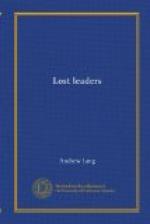the Tweed. He tells, with a humour like that
of Charles Lamb in his account of his youthful search
for the mysterious fountain-head of the New River,
how he sought among the Pentland Hills for the source
of the brook that flowed past his own garden.
The wandering stream led him through many a scene
renowned in Border history, up to the heights whence
Marmion surveyed the Scottish forces encamped on Borough
Moor before the fatal day of Flodden. These
scenes are described with spirit and loving interest;
but it is by Tweedside that the tourist will find his
most pleasant guide in Lauder’s book.
Just as Cicero said of Athens, that in every stone
you tread on a history, so on Tweedside by every nook
and valley you find the place of a ballad, a story,
or a legend. From Tweed’s source, near
the grave of the Wizard Merlin, down to Berwick and
the sea, the Border “keeps” and towers
are as frequent as castles on the Rhine. Each
has its tradition, its memory of lawless times, which
have become beautiful in the magic of poetry and the
mist of the past. First comes Neidpath Castle,
with its vaulted “hanging chamber” in the
roof, and the rafter, with the iron ring to which
prisoners were hanged, still remaining to testify
to the lawless power of Border lords. Neidpath
has a softer legend of the death of the lady of the
house, when her lover failed to recognize the features
that had wasted with sorrow for his absence.
Lower down the river comes Clovenfords, with its memories
of Christopher North, and Peebles, where King James
sings that there was “dancing and derray”
in his time; and still lower Ashiesteel, where Scott
was young and happy, and Abbotsford, where his fame
and his misfortunes found him out. It was on
a bright afternoon in late September that he died
there, and the mourners by his bed heard through the
silence the murmuring of Tweed How many other associations
there are by the tributary rivers! what a breath of
“pastoral melancholy”! There is Ettrick,
where the cautious lover in the old song of Ettrick
banks found “a canny place of meeting.”
Oakwood Tower, where Michael Scott, the wizard, wove
his spells, is a farm building—the haunted
magician’s room is a granary, Earlstone, where
Thomas the Rhymer dwelt, and whence the two white deer
recalled him to Elfland and to the arms of the fairy
queen, is noted “for its shawl manufactory.”
Only Yarrow still keeps its ancient quiet, and the
burn that was tinged by the blood of Douglas is unstained
by more commonplace dyes.
All these changes make the “Rivers of Scotland” rather melancholy reading. Thirty years have not passed since Lauder died, and how much he would miss if he could revisit his beloved water! Spearing salmon by torchlight is a forbidden thing. The rocks are no longer lit up with the red glow; they resound no longer with the shouts and splashing of the yeomen. You might almost as readily find a hart on Harthope, or a wild cat at Catslack, or a wolf at Wolf-Cleugh, as catch three stone-weight




